Slip Stitch Summer Cowl
If it’s summer and you’re in a draft or under a night sky, linen is just the thing for warming up without heating up. Our Slip Stitch Summer Cowl in Field Linen is a true summertime companion, naturally beautiful and cool-to-the-touch.
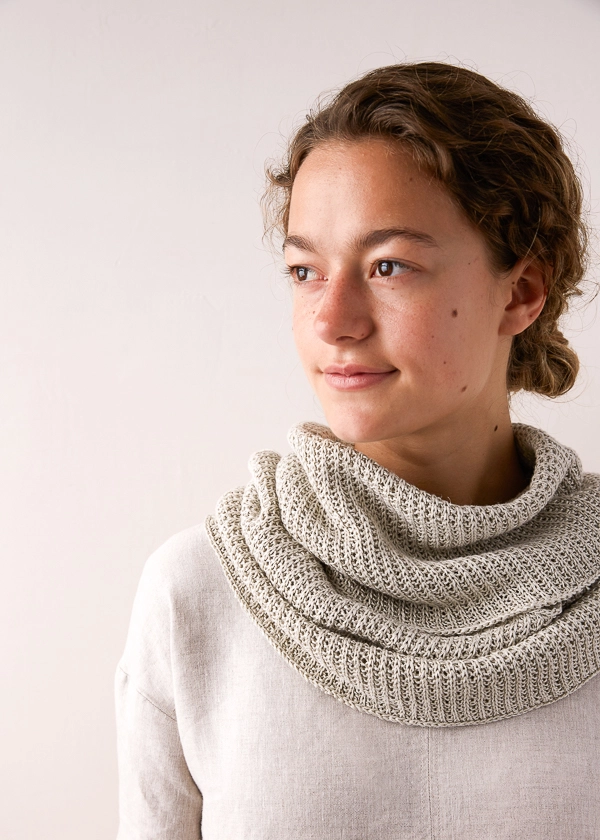
An easy-to-remember repeat of two rounds, this slip stitch pattern is just knitting one round, then alternating a slip and a purl on the next. Meditative knitting at its best!
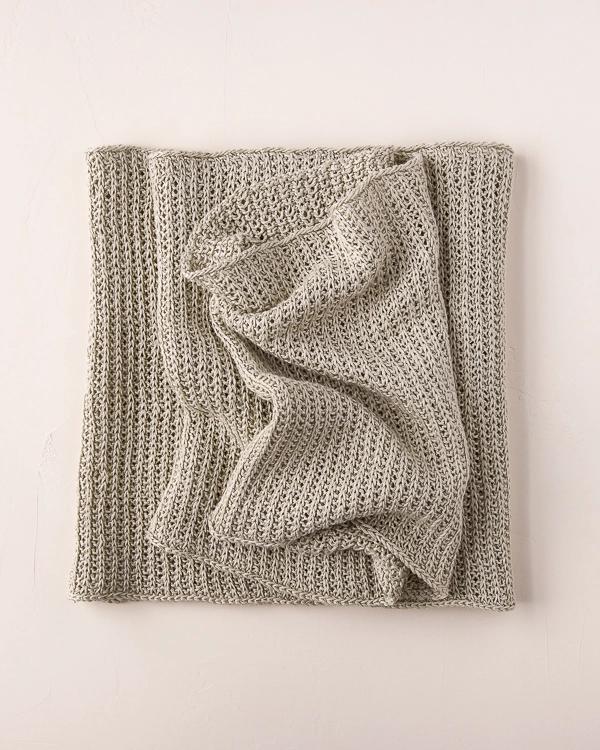
And in our Field Linen, this cowl has a crisp stitch definition, a lovely drape, and a pretty, soft sheen. Save luggage space and pack this project for summer travels… Just 3 skeins of Field Linen and a free pattern you can store in your brain!
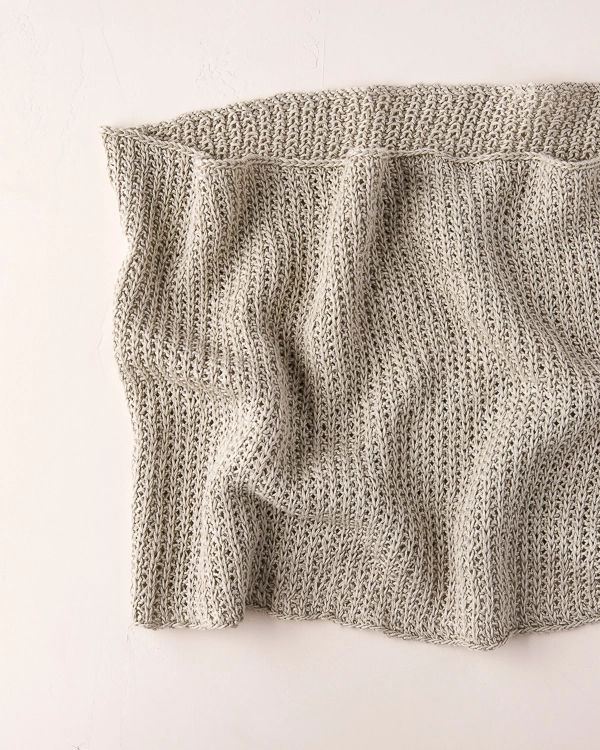
As casual to knit as it is to drape around yourself, this is what summer knitting is all about!
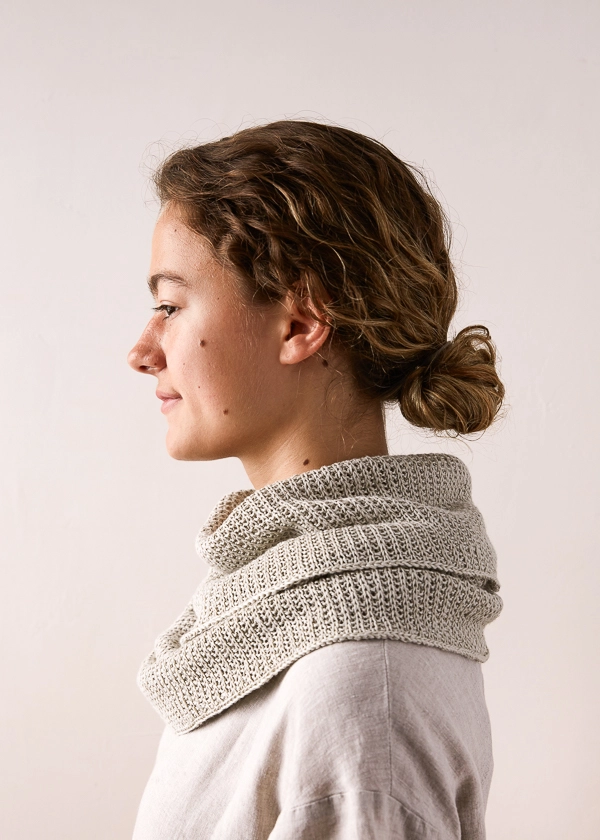
Designed by Purl Soho designer, Jake Canton. Click here to see even more of Jake’s designs!
Share your progress and connect with the community by tagging your pics with #PurlSoho, #PurlSohoBusyHands, #PurlSohoSlipStitchSummerCowl, and #PurlSohoFieldLinen. We can’t wait to see what you make!
Materials
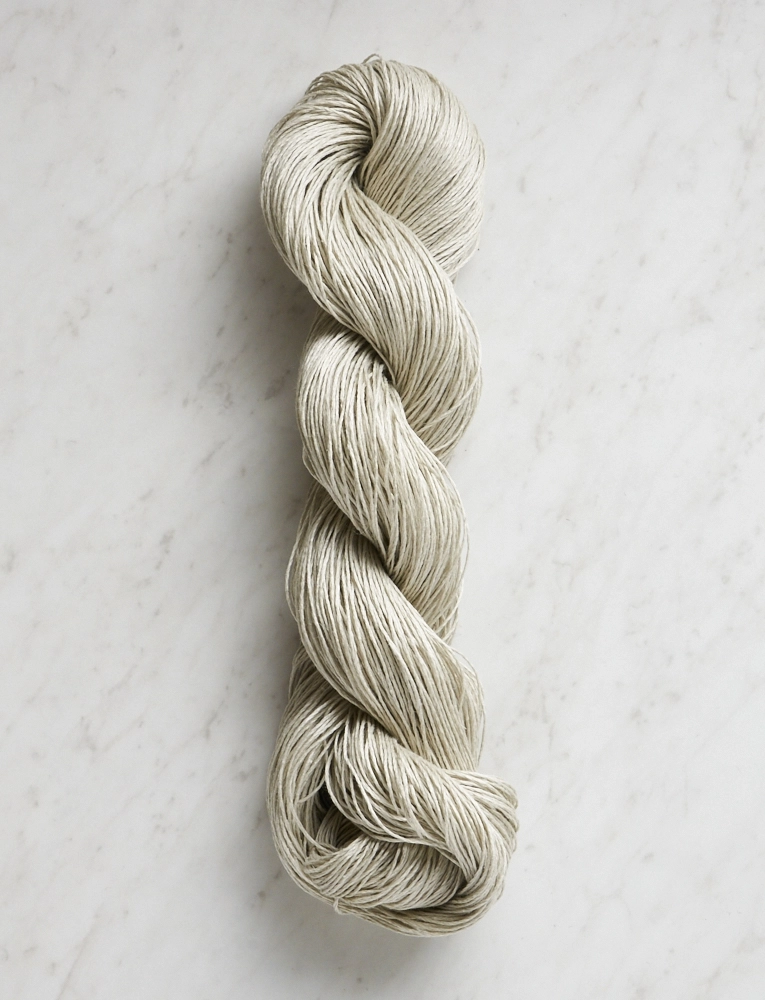
- 3 skeins of Purl Soho’s Field Linen, 100% linen. Each skein is 295 yards/ 100 grams; approximately 885 yards required. We used Silver Thistle.
- US 4 (3.5 mm), 32-, 40-, or 47-inch circular needles
- A stitch marker
Gauge
30 stitches = 4 inches in stitch pattern
Size
- Finished Height: 12 inches
- Finished Circumference: 56 inches
Note
Slip all slipped stitches purlwise.
Pattern
Cast on 420 stitches; We used a basic Long Tail Cast On. Place a marker and join for working in the round, being careful to not twist the stitches.
Round 1: Knit to end of round.
Round 2: *Slip 1 with yarn in back, p1, repeat from * to end of round.
Repeat Rounds 1 and 2 until piece measures 12 inches from cast-on edge, ending with Round 1.
Bind off knitwise.
Weave in the ends and block as desired!
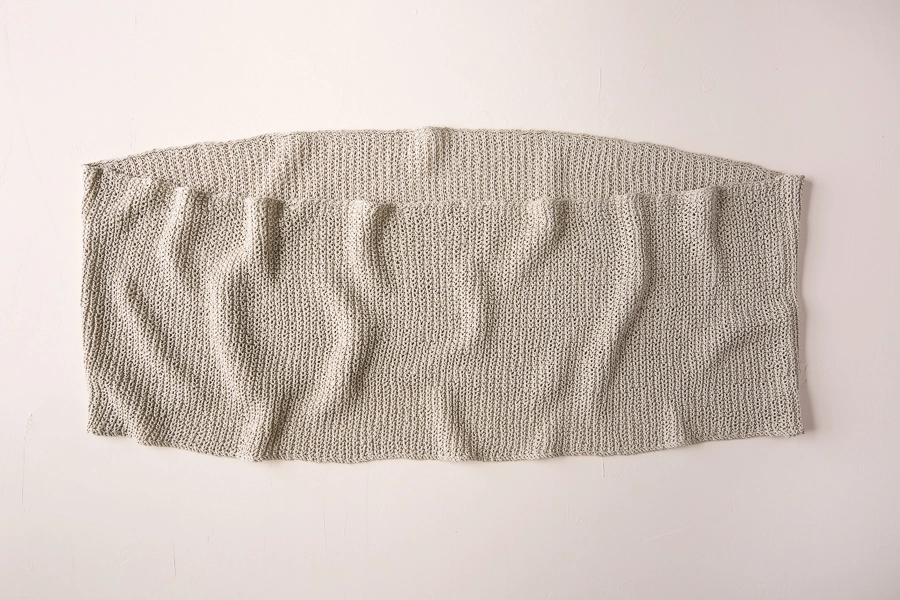

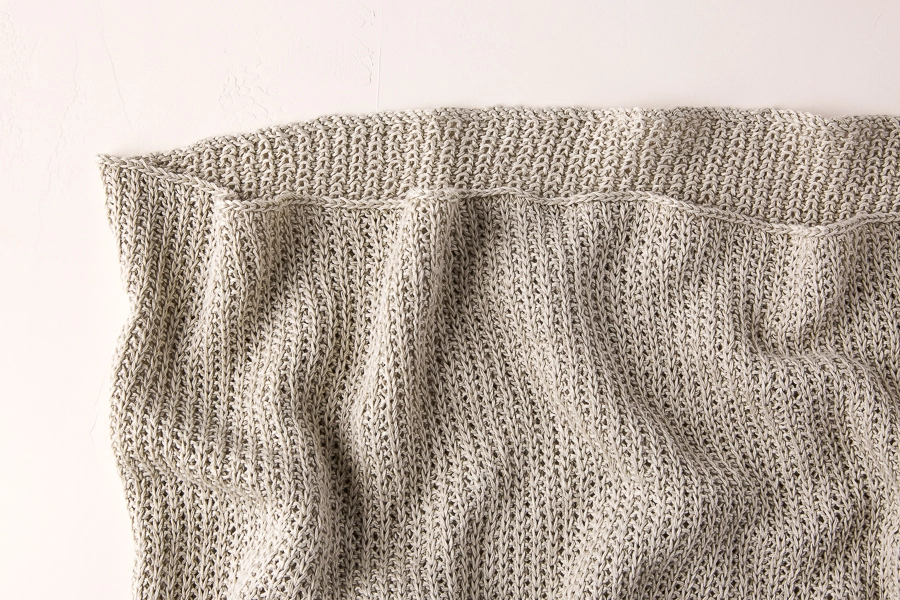
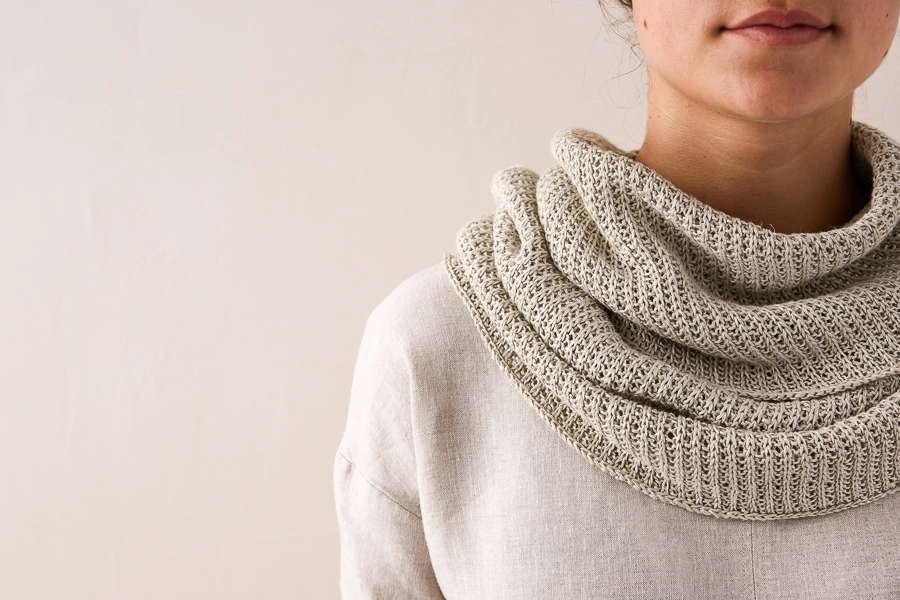
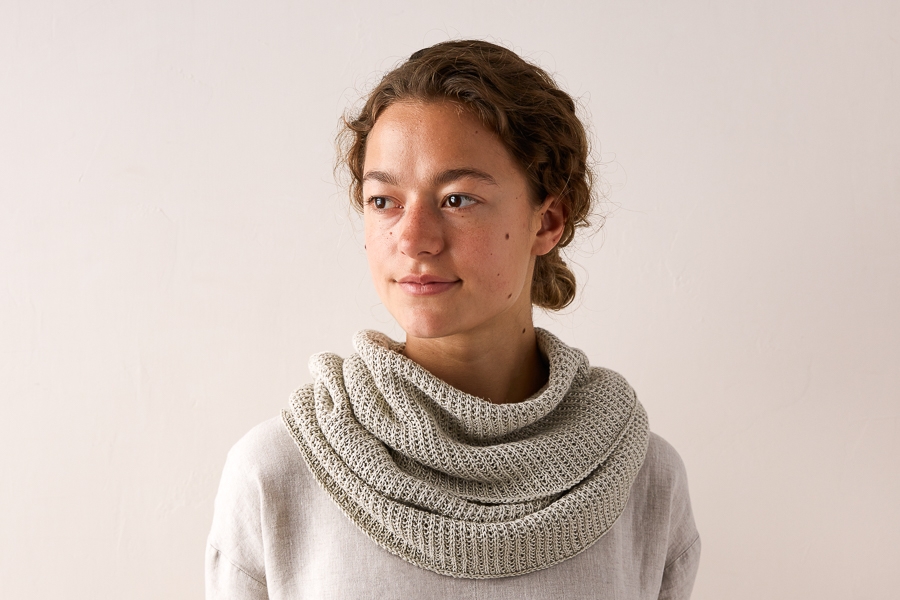
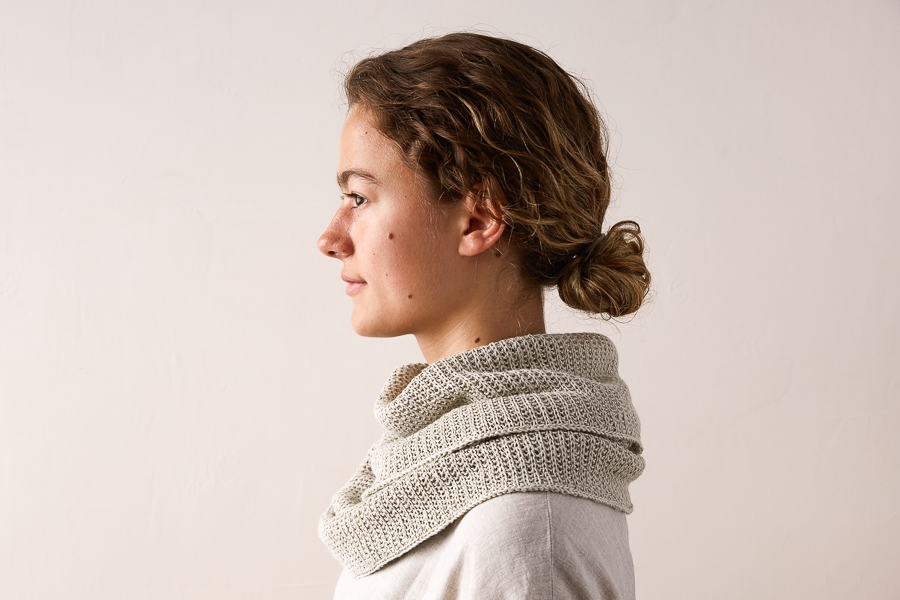
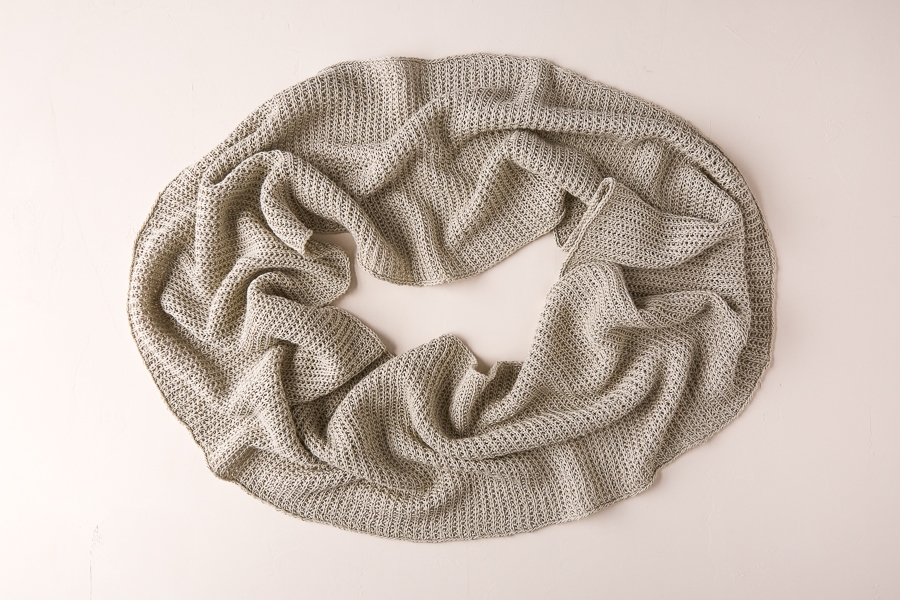


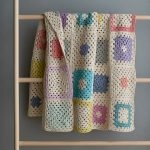

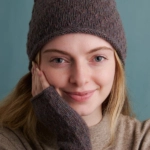
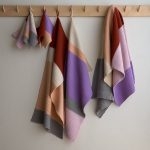
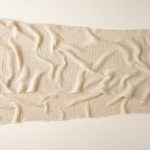
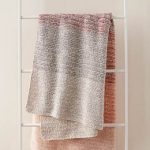
Would this pattern work with cotton pure?
Hi Lynn,
Thanks for writing in! I think this stitch pattern would be wonderful in Cotton Pure, though you will have to make a few pattern adjustments! I would suggest knitting a gauge swatch on a US 5 or 6 needles, and once you have measured your stitches per inch, multiply that number by 56 to get your cast on number. You will probably need three skeins of Cotton Pure to knit a similar sized cowl.
Happy knitting, and please let us know how your version turns out!
Julianna
Would love to see a crochet patterns.
Hi Daisy,
Thanks for writing in! We do not have a crocheted version of this cowl but I will pass your suggest along to the design team!
Best,
Julianna
Note says slip with yarn in front, pattern says with yarn in back.
When you do slip stitch, do you slip as if to knit or as if to purl?
Thanks.
Hi Monica,
Thanks for writing in! All slipped stitches in the pattern should be done purlwise with the yarn in back – in other words, although your yarn is in the back of the work, you will insert your needle into the stitch as if to purl while slipping it.
I hope that helps!
Julianna
this seems really long! 57″ around? shoulder to shoulder with drape like the photo I am only about 17″ thus doubled = 34″ seems like enough for a cowl. Doubled up it would be 68″ Bigger than the 57″ in pattern. Obviously I am looking at this wrong, is it that the second ‘wrap’ is designed to be much smaller?
Help! I am 5’0′ and do not want to be overwhelmed by the finished size. Melanie
Hi Melanie,
Thanks for reaching out! As you can see in the pictures, the cowl does not reach all the way to the tips of the model’s shoulders when worn doubled, so you are correct, 68″ would be much too long! A 57″ cowl should fit most people, especially in the lightweight, drapey fabric of Field Linen, but if you would prefer a shorter or single wrap cowl, the stitch pattern will work over any even number of stitches, so feel free to adjust the length however you like!
Best,
Julianna
Do you have any tips for not twisting stitches when working with such a large number of stitches?
If the stitches were inadvertently twisted would it matter for this pattern?
Thanks, Linda
Hi Linda,
Great question! It can be so frustrating to find a twist in a circular piece after you have already worked a few inches! I find it helpful to knit the first round before joining since it will be easier to see a twist around the needle when you have something a bit more substantial than just the cast on, and you can close up any gap when weaving in the tail of the cast on. You may also have an easier time if you use a longer circular needle – although the cowl will fit on a 32″ needle, if you choose a 40″ or 47″ needle you can spread the stitches out more which will make it easier to spot a twist.
I also like to do one last check after I have completed the first round after joining, because if there is a twist, you can still untwist it at this point when there is only a strand or two of yarn joining the cowl together without creating a too-obvious lump or bunchy area! If a twist does still manage to sneak past you, it is up to your preference whether you want to leave it – the slip stitch pattern does have an obvious right and wrong side, though the wrong side does still have a pleasing waffle-like texture.
I hope that helps!
Julianna
This looks very nice–if i wanted to knit it flat as a scarf, would the second row be knit instead of purl? Would the slip stitch be with yarn in front or back? Thank you!
Hi Jeanne,
Thanks for writing in and for the kind words! To work the Slip Stitch pattern flat, you will simply replace Round 1 with purls, and work Round 2 as written. I would also recommend casting on an odd number of stitches so your second row begins and ends with a slipped stitch, which will result in tidy, matching selvages on each side of the scarf!
Best of luck, and please let us know how your scarf turns out!
Julianna
Summer perfection! I fell in love with your Field Linen last summer! Thank you for this cowl. Slip stitch, Field Linen, my knitting cup runneth over!
Julie
Hi,
I was wanting to make this cowl, except far longer, and I was wondering how to increase it.
It is a beautiful pattern, thank you for sharing it. 🙂
Hi Caitlin,
Thank you so much for the kind words! The Slip Stitch pattern works over any even number of stitches, so if you are working at the correct gauge, you can multiply your desired length by 7.5 and round to the nearest even number to get your cast on number.
Best of luck and happy knitting!
Julianna
Thank you so much Julianna, I will get knitting 😀
Does one slip the stitch knit wise or purl wise…with the yarn in back?
Hi Susan,
Thanks for writing in! All slipped stitches in the pattern should be done purlwise with the yarn in back – in other words, although your yarn is in the back of the work, you will insert your needle into the stitch as if to purl while slipping it.
I hope that clears things up!
Julianna
Many thanks for your quick response! Such excellent customer service.
What a beautiful cowl you have presented to us! I am a beginning (but very enthusiastic) knitter. I have learned to knit, purl and alternative the two with ease. With one of your splendid tutorials, do you think a fledgling knitter could try making this lovely cowl?! Or, can you suggest another pattern for a cowl that might be more suitable…but just as beautiful?
Hi KayEllen,
Thanks for writing in and for the kind words! I think this would be an excellent project if you are comfortable with knitting and purling! While we don’t have a tutorial for slipping stitches with the yarn in back, it is a fairly straightforward technique. After purling the previous stitch, you will move your yarn to the back as if you were knitting, insert your needle into the stitch as if to purl and simply slip it to the right hand needle without working it. Move your yarn back to the front to purl the next stitch, and repeat!
I hope you feel encouraged to give this pattern a try! We are always here to help if you have any questions!
Best,
Julianna
Thanks for your helpful reply, Julianna … I’ve been watching for your response … and now am encouraged to start knitting this cowl. I just need to decide between the Prairie Clover and Blue Verbena colors of the linen yarn!
Warmly,
KayEllen
Hi there – what a nice pattern! Would this stitch/pattern with linem work for a tee/shirt without sleeves?
Thanks in advance!
Julia
Hi Julia,
Thanks for reaching out! I think this could result in a lovely top, with one caveat to keep in mind during the design phase! The slip stitch pattern removes a lot of the natural elastic nature of knit fabric, especially when worked in a yarn like linen that doesn’t have any inherent stretch, so you will want to make sure you have plenty of positive ease built in to your pattern. Otherwise, the slip stitch fabric in Field Linen is wonderfully drapey and light weight so it should create a beautiful summer top!
Best of luck, and please let us know how it turns out!
Julianna
HI – I have started this pattern but the reverse side does not look like yours. It looks more like garter stitch. Any ideas what I’m doing wrong. Thanks.
Hi Laura,
Thanks for writing in! It’s hard to tell exactly without seeing your work, but if the right side of your project looks correct, I don’t think this is a problem! The wrong side of the slip stitch pattern is much more textured than the right side, and when I tried a swatch in a different yarn it does look very similar to garter stitch. The smoother appearance of the wrong side in our cowl is probably due to the nature of linen and the effects of blocking. If you aren’t sure or if you are having problems with the right side of the pattern, please feel free to send a picture of your cowl to customerservice@purlsoho.com so we can troubleshoot this for you!
Best,
Julianna
Thanks so much for replying. I think you’re right that it’s the yarn I’m using because I did a swatch with a linen type yarn and it looked more like yours. Thanks again. x
Hi,
Wich is the best cast on method for this pattern?
Thanks
Hello Fernanda,
Thank you for reaching out! I would recommend using a long tail cast on for this project.
Happy knitting,
-Marilla
Thank you!
Would linen quill work well in this pattern in terms of drape and feel? I’m assuming there would be little to no adjustment in knitting since field linen and linen quill are the same weight. If I’m wrong, please let me know! I love your site and excellent customer service!
Hi Jackie,
Thanks for writing in and for the kind words! It is still a good idea to knit a gauge swatch whenever you substitute yarns, but you are correct that Field Linen and Linen Quill are just about the same weight so it should work out nicely! I find Linen Quill to be quite drapey, especially after being washed and blocked a few times – although it will make a significantly warmer cowl than Field Linen, it will turn out just as lovely!
Happy knitting!
Julianna
Thanks for your prompt reply. Now I have to decide on how warm I want the cowl to be!
I love this pattern. Do you think it could be knit in a merino/silk blend at fingering weight?
Thank you
Hello Susan,
This is a great question! You can knit this cowl with any fingering weight yarn, though knitting it with an animal fiber will change the texture of the knitted fabric.
Happy knitting,
Marilla
I have never knit with linen. Most of my knitting has been with DK or worsted. Any suggestions/tips?
Hi Joyce,
Thanks for reaching out! Linen can be a bit stiff and hard on your hands if you aren’t used to it. The best thing to do is try to keep your hands relaxed and knit loosely, even if that means moving down a needle size or two to obtain gauge, and taking breaks if your hands start getting tired!
I hope that helps!
Julianna
I’m super confused by this pattern 🙂 It looks like you knit row 1, purl row 2 and alternate that for the whole scarf which would make horizontal stripes. But the picture looks like a knit 1, purl 1 pattern for each row which would make for vertical stripes. Help!
Hi Kate,
Thanks for reaching out! On Row 2 of the pattern, you will be slipping every other stitch with the yarn in back, which creates the vertical lines of slipped stitches you can see in the images. If you haven’t tried a slip stitch pattern before I encourage you to try at least a swatch – it’s a very simple stitch that creates a really lovely texture!
Best,
Julianna
Hi. I think I would like to work this with your Line Weight.
Would two skeins make two? Also, do you think the pattern would show up with the darker yarn colors? I think it looks quite beautiful in the light color that you used.
Thanks!
Hello Stephanie,
Thank you for reaching out! This is a lovely idea! This cowl takes approximately 885 yards to complete so you will need two skeins of line weight for one cowl, but you could make two cowls with three skeins.
I hope this helps and happy knitting!
-Marilla
It is very lovely and soft in the line weight. I am so happy that I used it and highly recommend it!
~Stephanie
I am currently working on this (love how it is turning out!) and am coming to the end of my first ball of yarn. This is my first time working with pure linen. I am going to try the magic knot to join my second ball but am wondering if there is a suggested join for field linen? Thanks!
Hi Francesca,
Thanks for reaching out! Because linen is a fairly slippery, stiff fiber, I don’t think I would trust a knot for joining the second skein! We recommend adding new balls of yarn by simply starting to knit with the new strand, leaving 6-7″ tails of both the old and new yarns, and then weaving in these ends. This would be the most secure way to join, especially with a less grippy yarn!
I hope that helps!
Julianna
I started this cowl using the needle size recommended (US 4) and the number of stitches (420). After about one inch of knitting I made a mistake I couldn’t fix, so I pulled the knitting off the needles. I then measured the circumference, because it looked way too big, and found it to be just shy of 80”, not 56!!! (I hadn’t done a swatch, so this came as a surprise.) I decided to start again, reducing the number of cast on stitches to 56/80 of 420, or 294! This is working out for me. My point: I think 420 stitches would ALWAYS be too many for a 56-inch cowl, using this yarn and size 4 needles. I had cast on the stitches so tightly I could barely knit them in the first row, and don’t see how they could have been put on any tighter! Further, I was surprised that the yarn is so much coarser than, for instance, the linen quill, since both are called fingering gauge.
I love the cowl, and the yarn. I just wonder how the number of stitches could be right, as written!
Hi Susan,
Thanks for writing in! I am sorry to hear that you had difficulties with this pattern! The gauge that we get in this stitch pattern is 30 stitches = 4 inches in stitch pattern or 7.5 stitches per inch. The cast on of 420 stitches divided by 7.5 stitches per inch gives us the circumference of 56 inches. Gauge with linen can be a bit tricky as it behaves so differently from wool. Sometimes this can mean going down a needle size or two to get gauge if you are not used to working with it.
As to the feeling of the yarn, linen does start with a bit more of a coarse feeling. After working with it, washing it and wearing it, it does soften up quite a lot!
I do hope that this helps and I am glad to hear that you found a way to make this pattern work for you!
Cassy
Can I use any alpaca yarn or merino wool for this pattern?
Hello Yvonne,
Thank you for reaching out! You certainly can, as long as you are getting the correct gauge!
Happy knitting!
-Marilla
Do you think I could use Burnish to knit this?
Hi TJ,
Thanks for reaching out! Yes, Burnish would be a wonderful alternative for this cowl! The fabric would have even more gorgeous drape and flow than our linen version.
Happy knitting, and please do let us know how it turns out!
Julianna
What is the repeat on this pattern? Divisible by two or four?
Hi Donna,
Great question! This pattern will work with any even number of stitches.
Happy knitting!
Julianna
I wanted to make a flat knitted scarf in the Slip Stitch Summer Cowl pattern with 3 skeins of Field Linen. It was recommended to cast on an odd amount of stitches. How many stitches should I cast on? Thanks so much for your help. This will be pure knitting joy for a long road trip.
Hi Pam,
Thanks for writing in! To figure out your cast-on number, you will want to first knit a gauge swatch in pattern. Once you know how many stitches you are getting per inch, you can multiply that number by the width that you would like and cast on the nearest odd number. Then you can knit the scarf as long as you’d like! This sounds like a wonderful road trip project.
All the best,
Lili
Thank you so much, your reply is much appreciated. Can’t wait to cast on your linen is just beautiful. Thanks again.
Bonjour à tous,
D’abord mille bravos pour vos modèles somptueux et expliqués gratuitement.
Pourriez-vous me dire si ce point utilisé pour ce Slip Stich Summer Cawl est le point de tissage ou de lin?
Je ne comprends que le français et en plus que les vidéos.
J’aimerais tellement offrir ce col a mes petits-enfants chéris mais je dois voir le point effectué en vidéo pour y arriver.
Je lance un SOS.Mamiannie.
Hello,
I’m glad to hear that this pattern has caught your eye! This cowl is knit, not woven, and the stitch isn’t quite linen stitch. However, it shares some similarities with linen stitch, since it incorporates slipped stitches to create the textured pattern! All you do is knit one round, and then on the second round, alternate slipped stitches (with yarn in back) with purl stitches. As you repeat these two rounds, the pattern will emerge!
All the best,
Lili
Would this pattern look good in dark brown linen? Thanks carol
Hi Carol,
Thanks for your question! Absolutely, this cowl would look fabulous in a dark brown linen yarn! Any fingering weight linen yarn would be excellent for this project. I hope this helps, and let us know if you have any other questions!
All the best,
Cat
For this pattern I have more of a ginger color linen.will that look ok? Thanks Carol
Hi Carol,
Absolutely, that would also work great for this pattern and look amazing! As long as the yarn is a fingering weight and can stay consistent with the gauge of the pattern, you should be all set!
All the best,
Cat